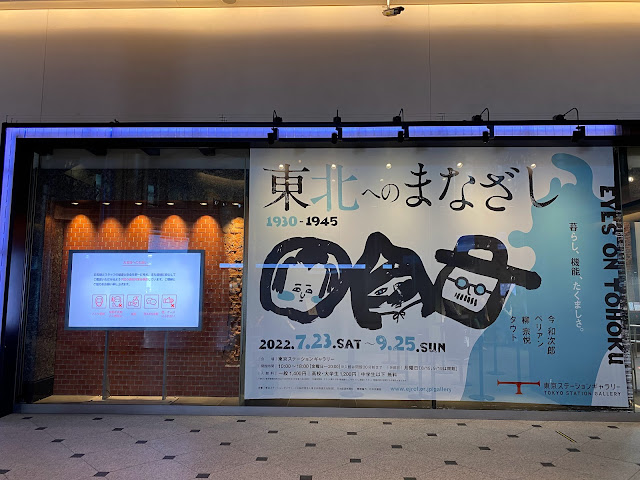1930年から1945年にかけて、年号で言えば昭和5年から20年にかけて、東北へそのまなざしを向けた人々に焦点を当てた展覧会。
ブルーノ・タウト、柳宗悦、シャルロット・ペリアンらの東北との関係については、別の機会で知っていたので、それらを思い出すと言った風で会場を巡った。
考現学で知られる今和次郎は東北の青森生まれで、その青森を中心に弟の純三とともに東北を広く”考現学”していたことはこの展覧会で初めて知った。
また、シュルレアリスムの画家だった吉井忠が、福沢一郎と瀧口修造が警察に逮捕されたことをきっかけに故郷に故郷の福島に戻り、東北地方の人々や風景を描き続けた作品も、この展覧会で初めて目にした。
中でも、東北地方の様々なこけしが、かつての東京駅の赤煉瓦の古い壁の前にまとめて展示されていたコーナーが衝撃的だった。
東北といえば、縄文土器、三内丸山遺跡、アイヌ、蝦夷、奥州藤原氏、奥の細道、宮沢賢治、宗像思考、東日本大震災、福島原発事故など、様々なことが思い浮かんで来る。
その中に、この展覧会のことも、入ってしまったような気がする。
From 1930 to 1945, this exhibition focuses on the people who turned their eyes to Tohoku.
I had learned about the relationship with Tohoku of Bruno Taut, Soetsu Yanagi, Charlotte Perriand, etc. on another occasion, so I went around the venue, reminding myself of them.
Wajiro Kon, who is known for modern studies, was born in Aomori, Tohoku, and I learned for the first time at this exhibition that he and his younger brother Junzo had been involved in "modern studies" across the Tohoku region, mainly in Aomori.
In addition, the surrealist painter Tadashi Yoshii returned to his hometown of Fukushima after Ichiro Fukuzawa and Shuzo Takiguchi were arrested by the police, and continued to paint the people and landscapes of the Tohoku region. I saw his works for the first time at a party.
I was particularly struck by the corner where various kokeshi dolls from the Tohoku region were displayed in front of the old red brick wall of what used to be Tokyo Station.
When you think of Tohoku, various things come to mind, such as Jomon pottery, the Sannai Maruyama ruins, Ainu, Ezo, the Oshu Fujiwara clan, Oku no Hosomichi, Kenji Miyazawa, Munakata thought, the Great East Japan Earthquake, and the Fukushima nuclear accident.
I feel like this exhibition has been included in that.

コメント
コメントを投稿